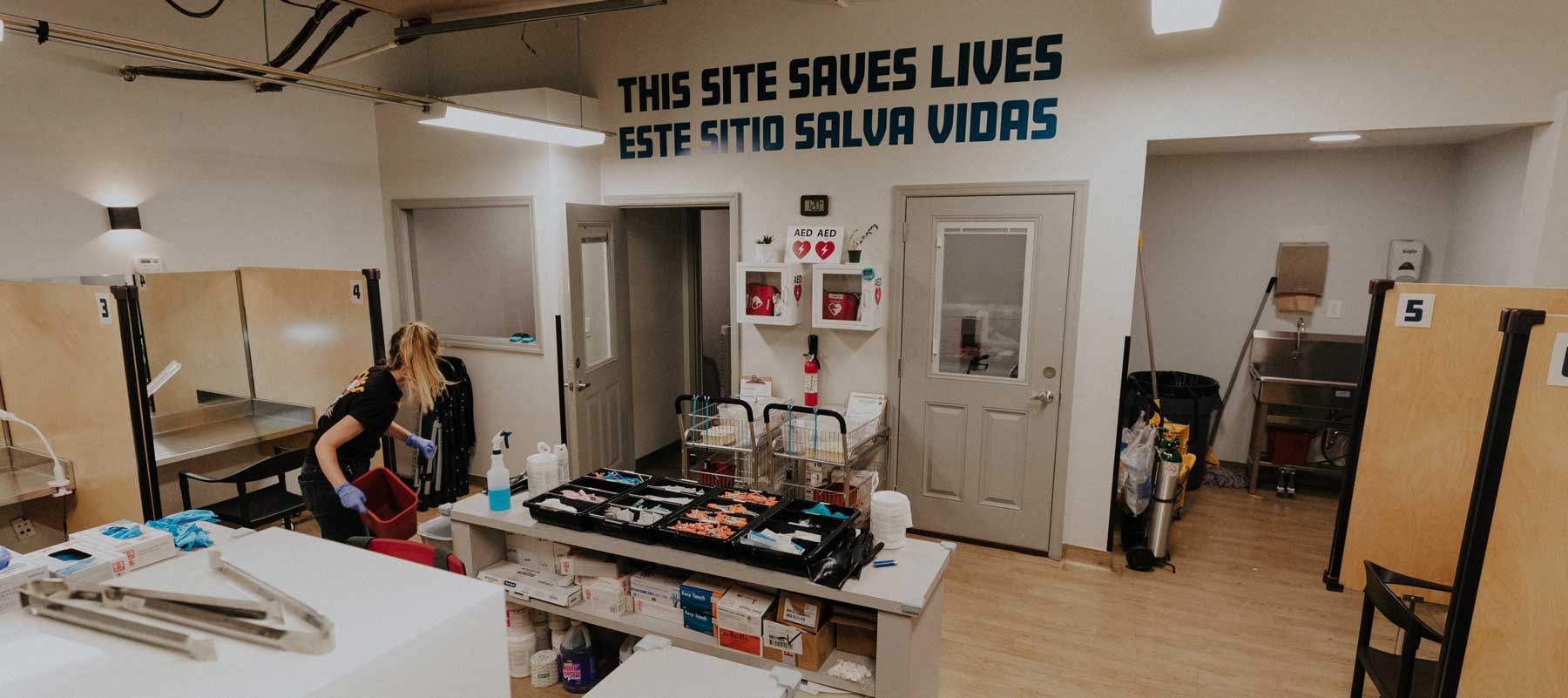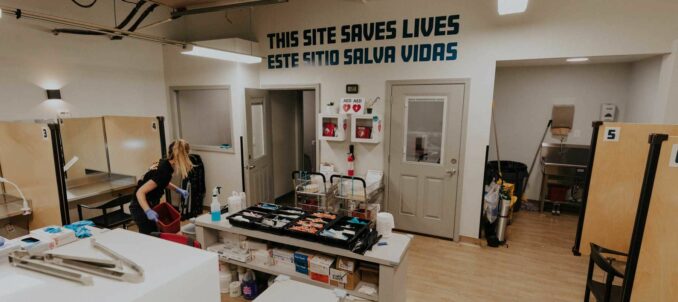

Sign at New York City safe consumption site reads: “This Site Saves Lives”
Philadelphia
As the opioid and overdose epidemics worsen, there is a need to embrace radical solutions to save lives. One of these solutions is safe consumption sites (also called safe injection sites). These sites have opened in various places and have been shown to work in preventing overdose deaths.Human Immunodeficiency Virus (HIV) and Hepatitis C Virus (HCV) diagnoses and other medical emergencies such as abscesses and skin disorders can occur when an individual is using drugs intravenously.


Sign at New York City safe consumption site reads: “This Site Saves Lives”
The opposition was based on NIMBYism (Not In My Back Yard), the view that having a safe injection site nearby will cause harm, or on a flawed concept of what addiction is. Rather than viewing it as a disease or mental illness, site opponents treated addiction as a moral failure.
This view of addiction as a moral failure has persisted for at least two centuries, despite the intervention of medical professionals, groups like Alcoholics Anonymous which first pioneered the idea of alcoholism and addiction being diseases and addicts in recovery sharing their stories about what it means to be addicted to a drug — including alcohol.
Safe consumption saves lives
There is scientific and sociological proof that safe injection sites prevent overdoses. Insite alone, between March 2003 and April 2004, saw almost 5,000 people — a significant portion of them people of color and women. There were 273 overdoses with not a single overdose death. There were over 2,000 referrals to drug treatment programs for people ready to seek recovery from addiction.
At OnPoint NYC — the first governmentally sanctioned in-person set of safe consumption sites in the United States — almost 4,000 people used the sites with over 1,000 overdoses prevented or countered.
Safe injection site opponents who appeal to NIMBYism frequently block or redirect all addiction-related services and programs: rehabilitation centers, detoxification centers, methadone and buprenorphine (Suboxone, Subutex, Sublocade, Brixadi and Zubsolv) clinics, sober living homes and needle exchanges. These programs have been in action for several decades, longer than safe consumption sites. Now with this 21st century solution to a 21st century drug epidemic, these forces oppose safe consumption sites.
The Philadelphia experience
In Philadelphia, these NIMBYs are both right-wing Republicans and “progressive” Democrats. In the so-called “City of Brotherly Love,” a bill to ban the opening of a safe consumption site, Safehouse, passed in the City Council 13-1. The council members in charge of the bill, Quetcy Lozada (who represents portions of the Kensington section of the city, where the drug epidemic is mostly centered) and Jim Harrity managed to get almost every council member to take the position that Safehouse would be a negative force in the community.
They promoted the idea that a safe consumption site would become a crime magnet, a crack house or some kind of drain on society, along with the view that the sites “enable” the user to keep using. This caused division in the community. Harm reductionists, people in recovery and friends and family members of those who have died of drug overdoses came together to support the existence of a Philadelphia-based safe consumption site. On the other side were community members strongly opposed to having one in their neighborhoods.
Meanwhile, according to the Philadelphia Inquirer, Oct. 3: “Fatal overdoses among Philadelphians are higher than ever. And drug deaths are rising dramatically among Black and Hispanic Philadelphians, even as fewer white residents are dying of overdoses, city officials said in a wide-ranging report on overdose deaths in 2022.
“Between 2018 and 2022, health officials say, fatal overdoses among Black Philadelphians nearly doubled, from 347 to 649 deaths. Deaths among Hispanic Philadelphians increased by 43%. In the same time period, deaths among white residents decreased by 12%. In 2022, Black men saw the highest number of overdose fatalities among any demographic group in the city.”
The sole vote against the anti-Safehouse bill came from council member Kendra Brooks, Working Families Party. Council member Jamie Gauthier was not present at the vote but acknowledged that a safe consumption site would save the lives of Philadelphians.
Mayor Jim Kenney said he supports Safehouse and vetoed the bill, but the City Council overrode his veto 13-to-1. The passage of this bill banning safe consumption sites means many more people will die needlessly.
Safehouse — or any organization seeking to open a safe consumption site — can seek special permissions to open a site in their neighborhood after this bill is passed, but community organizations must approve it. Then the zoning board would take their vote into consideration. In typical political fashion, some of the people behind the bill claim it isn’t a ban but instead a “conversation starter” that would include the community.
Statewide ban pushed
The Commonwealth of Pennsylvania, additionally, seeks to ban the opening of safe consumption sites anywhere in the state. A bill to ban the sites was passed in the state Senate with the support of every Republican and most Democrats. Due to the controversy of the sites among Democrats, however, it may not get through the state House of Representatives. Democratic Gov. Josh Shapiro promised to support the ban and says he opposes the sites.
The importance of these sites cannot be overstated. Year after year, the number of fatal and non-fatal overdoses increases. While there are “mobile” and home-based safe consumption harm reduction groups — such as Never Use Alone, where drug users call in and can get help if they overdose — these are not enough. Statistics from all over North America have shown the usefulness of these sites and how they act to preserve life.
Harm reductionists, drug users, concerned friends and family members and revolutionaries need to get involved in the fight for safe consumption sites, in Philadelphia and the entire country. These sites do not attract crime (any more than any other public service does), they do not “encourage” drug abuse, and — unlike what the federal government has said — they do not act as “sanctioned suicide” facilities or crackhouses.
There must be a concerted fight to save lives.
The epic struggle of the Palestinian people against the full weight of U.S. imperialism and…
The following report comes from the Bronx Anti-War Coalition organizers on a protest held in…
In the Canadian federal elections held on April 28, the Liberals won with 169 seats…
The following is Part 2 of a talk given by the author to a meeting…
Boston Students, professors and workers are confronting the Trump administration’s fascist crackdown at universities across…
Philadelphia Within days of Swarthmore students reviving a pro-Palestinian encampment on April 30, police arrested…